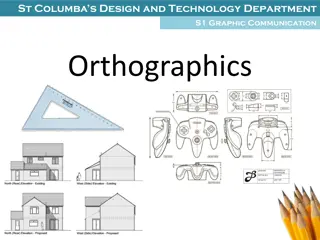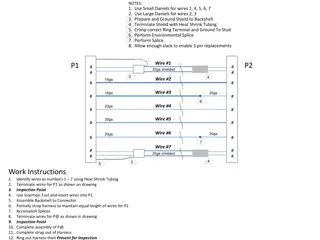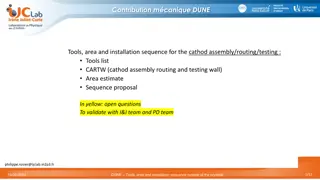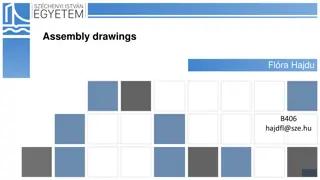Anupam Saxena's ME 251 Lecture III - Part and Assembly Drawings: Example II
Anupam Saxena, a professor in Mechanical Engineering at the Indian Institute of Technology Kanpur, presents a detailed study on part and assembly drawings in ME 251 Lecture III. The lecture covers examples such as non-return valves, threaded fasteners, bolts, nuts, sizes, proportions, and representation types. The content includes images and descriptions prepared by Anupam Saxena, Vitthal Khatik, and Ishu Agrawal. Dive into the intricate world of mechanical engineering and learn about components and their specifications. Gain insights into design and assembly processes through practical illustrations and educational resources.
Download Presentation

Please find below an Image/Link to download the presentation.
The content on the website is provided AS IS for your information and personal use only. It may not be sold, licensed, or shared on other websites without obtaining consent from the author.If you encounter any issues during the download, it is possible that the publisher has removed the file from their server.
You are allowed to download the files provided on this website for personal or commercial use, subject to the condition that they are used lawfully. All files are the property of their respective owners.
The content on the website is provided AS IS for your information and personal use only. It may not be sold, licensed, or shared on other websites without obtaining consent from the author.
E N D
Presentation Transcript
ME 251 Anupam Saxena Professor Mechanical Engineering Compliant and Robotic Systems Lab Indian Institute of Technology Kanpur
ANUPAM SAXENA ME 251 LECTURE III PART AND ASSEMBLY DRAWINGS: EXAMPLE II
NON-RETURN VALVE 20 190 140 200 140 200 140 ANUPAM SAXENA ME 251 LECTURE III PART AND ASSEMBLY DRAWINGS: EXAMPLE II Prepared by Anupam Saxena, Vitthal Khatik and Ishu Agrawal
NON-RETURN VALVE 25 25 12 48 90 ANUPAM SAXENA ME 251 LECTURE III PART AND ASSEMBLY DRAWINGS: EXAMPLE II Prepared by Anupam Saxena, Vitthal Khatik and Ishu Agrawal
NON-RETURN VALVE 112 6 45 90 100 ANUPAM SAXENA ME 251 LECTURE III PART AND ASSEMBLY DRAWINGS: EXAMPLE II Prepared by Anupam Saxena, Vitthal Khatik and Ishu Agrawal
190 NON-RETURN VALVE 120 6 HOLES,DIA 18 PCD 150 ANUPAM SAXENA ME 251 LECTURE III PART AND ASSEMBLY DRAWINGS: EXAMPLE II
THREADED FASTENERS Bolts and nuts- size and proportions Representation types: A. Detailed B. Schematic C. Simplified D 2D 30o 0.75 D R=1.5D L 2D D D Ref: http://eon.sdsu.edu/~johnston/Eng_Graphics_Essentials_5th_Ed/files/ege/fast/fast_page5.htm
THREADED FASTENERS Bolts and nuts- size and proportions Representation types: A. Detailed B. Schematic C. Simplified D 2D 30o 0.75 D R=1.5D L 2D A bit more work but realistic feeling D D Ref: http://eon.sdsu.edu/~johnston/Eng_Graphics_Essentials_5th_Ed/files/ege/fast/fast_page5.htm
THREADED FASTENERS Bolts and nuts- size and proportions Representation types: A. Detailed B. Schematic C. Simplified D 2D 30o 0.75 D R=1.5D L 2D A LOT more work TRUE LOOK D D Ref: http://eon.sdsu.edu/~johnston/Eng_Graphics_Essentials_5th_Ed/files/ege/fast/fast_page5.htm
NON-RETURN VALVE 28 M10 ANUPAM SAXENA ME 251 LECTURE III PART AND ASSEMBLY DRAWINGS: EXAMPLE II Prepared by Anupam Saxena, Vitthal Khatik and Ishu Agrawal
NON-RETURN VALVE 60 20 M16 ANUPAM SAXENA ME 251 LECTURE III PART AND ASSEMBLY DRAWINGS: EXAMPLE II Prepared by Anupam Saxena, Vitthal Khatik and Ishu Agrawal
NON-RETURN VALVE: ASSEMBLY COMMON MISTAKES Direction of hatch lines ? Careful of EXTRA lines when ASSEMBLING The top right corner Make sure to number parts and prepare the BILL of material ANUPAM SAXENA ME 251 LECTURE III PART AND ASSEMBLY DRAWINGS: EXAMPLE II Prepared by Anupam Saxena, Vitthal Khatik and Ishu Agrawal
Revisiting Tolerances Terminology Actual Size Actual measured dimension of the part. Basic Size The size with reference to which the limits of size are fixed. Zero Line It is the straight line corresponding to basic size. Deviations are measured from this line. Tolerance Zero line Min. Diameter Max. Diameter Basic size
Tolerances Limit of Size The two extreme permissible sizes of a part between which the actual size should lie. Maximum Limit of Size The greater of the two limits of size. Minimum Limit of Size The smaller of the two limits of size. Tolerance zone Difference between the minimum and maximum limit size. Upper Deviation It is the algebraic difference between the maximum size and the basic size. Lower Deviation - It is the algebraic difference between the minimum size and the basic size. Upper deviation Lower deviation Upper deviation Lower deviation Tolerance Tolerance Zero line Max. Diameter Min. Diameter Basic size
Tolerances Specification of Tolerances Dimensional Geometric Dimensional Tolerance Amount by which a specified dimension is allowed to vary. Geometric Tolerance These are applied to features.
Tolerances Specification of Dimensional Tolerances Unilateral Tolerance Bilateral Tolerance Unilateral Tolerance 0.4 200 Dimension of part is permitted to vary only on one side of the basic size: Bilateral Tolerance 0.4 20-0.3 Dimension of part is permitted to vary both sides of the basic size:
Tolerances Designation of Tolerance IT Tolerance grade of hole IT Tolerance grade of shaft 25 H 7 f 6 Basic size of hole and shaft Fundamental deviation of hole Fundamental deviation of shaft Details to follow later
Think where you would want to provide tolerances ? Guesstimate on what kind? ANUPAM SAXENA ME 251 LECTURE III PART AND ASSEMBLY DRAWINGS: EXAMPLE II























